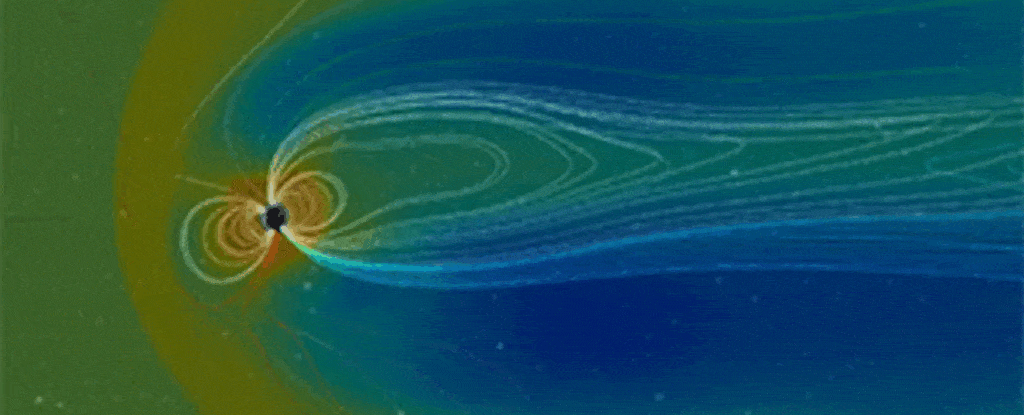Earth's magnetic field dramatically flipped a little more than 40,000 years ago. We can now experience this upheaval as an unnerving clatter interpreted from information collected by the European Space Agency's Swarm satellite mission.
Combining the satellite data with evidence of magnetic field line movements on Earth, European geoscientists mapped the so-called Laschamps event and represented it using natural noises like the creaking of wood and the crashing of colliding rocks.
The resulting compilation from the Technical University of Denmark and the German Research Center for Geosciences is unlike anything you've ever heard.
Generated by the swirling liquid metals in our planet's core, Earth's magnetic field reaches tens to hundreds of thousands of kilometers into space, protecting us all by deflecting atmosphere-stripping solar particles.
In its current orientation, the field lines form closed loops that are directed south to north above the planet's surface, and then north to south deep within it. Yet every so often the field randomly flips its polarity. Were this to happen again today, our north-pointing compasses would point to the South Pole.
The last such cataclysmic event occurred about 41,000 years ago, leaving a signature in the Laschamps lava flows in France. As the field weakened to only 5 percent of its current strength the reversal process allowed a surpluss of cosmic rays to pass into Earth's atmosphere.
Ice and marine sediment preserve isotopic signatures of this higher-than-normal solar bombardment, with levels of beryllium-10 isotopes doubling during the Laschamps event, according to a study published earlier this year.
These altered atoms are formed when cosmic rays react with our atmosphere, ionizing the air and frying the ozone layer. With global climate change being a potential consequence, it's speculated the extinction of Australia's megafauna as well as changes in human cave use may have been associated with this event.
"Understanding these extreme events is important for their occurrence in the future, space climate predictions, and assessing the effects on the environment and on the Earth system," German Research Center for Geosciences geophysics Sanja Panovska explained at the time.
It took 250 years for the Laschamps reversal to take place and it stayed in the unusual orientation for about 440 years. At most, Earth's magnetic field may have remained at 25 percent of its current strength as the north polarity drifted to the south.
Recent magnetic field anomalies like the weakening over the Atlantic ocean have led to questions about an impending reversal today, but recent research suggests these anomalies are not necessarily connected to flipping events.
The South Atlantic anomaly is, however, exposing satellites in the area to higher levels of radiation.
Since 2013, ESA's Swarm constellation has been measuring magnetic signals from Earth's core, mantle, crust, oceans, ionosphere, and magnetosphere so we can better understand our planet's geomagnetic field and predict its fluctuations.
